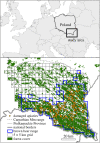Spatial ecology of conflicts: unravelling patterns of wildlife damage at multiple scales
- PMID: 34465240
- PMCID: PMC8437235
- DOI: 10.1098/rspb.2021.1394
Spatial ecology of conflicts: unravelling patterns of wildlife damage at multiple scales
Abstract
Human encroachment into natural habitats is typically followed by conflicts derived from wildlife damage to agriculture and livestock. Spatial risk modelling is a useful tool to gain the understanding of wildlife damage and mitigate conflicts. Although resource selection is a hierarchical process operating at multiple scales, risk models usually fail to address more than one scale, which can result in the misidentification of the underlying processes. Here, we addressed the multi-scale nature of wildlife damage occurrence by considering ecological and management correlates interacting from household to landscape scales. We studied brown bear (Ursus arctos) damage to apiaries in the North-eastern Carpathians as our model system. Using generalized additive models, we found that brown bear tendency to avoid humans and the habitat preferences of bears and beekeepers determine the risk of bear damage at multiple scales. Damage risk at fine scales increased when the broad landscape context also favoured damage. Furthermore, integrated-scale risk maps resulted in more accurate predictions than single-scale models. Our results suggest that principles of resource selection by animals can be used to understand the occurrence of damage and help mitigate conflicts in a proactive and preventive manner.
Keywords: Ursus arctos; beehives; human–wildlife coexistence; multi-scale analysis; spatial risk modelling; wildlife damage.
Conflict of interest statement
We have no competing interests.
Figures




References
-
- Frank B, Glikman JA, Marchini S. 2019. Human–wildlife interactions: turning conflict into coexistence. Cambridge, UK: Cambridge University Press.
-
- Redpath SM, Gutiérrez RJ, Wood KA, Young JC. 2015. Conflicts in conservation: navigating towards solutions. Cambridge, UK: Cambirdge University Press.
-
- Bautista C, et al. 2019. Large carnivore damage in Europe: analysis of compensation and prevention programs. Biol. Conserv. 235, 308-316. (10.1016/j.biocon.2019.04.019) - DOI
-
- Miller JRB. 2015. Mapping attack hotspots to mitigate human–carnivore conflict: approaches and applications of spatial predation risk modeling. Biodivers. Conserv. 24, 2887-2911. (10.1007/s10531-015-0993-6) - DOI
Publication types
MeSH terms
Associated data
LinkOut - more resources
Full Text Sources

